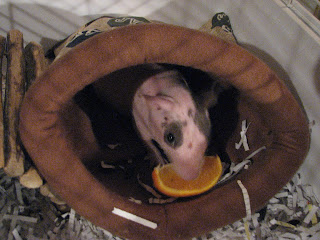It's tough for some teachers to avoid the "June Slide", when report cards are done (or nearly done) and when it's difficult to keep the restless students' attention. The beautiful weather and exhaustion following all those end-of-year tasks (graduation, moving rooms, filing OSRs, etc.) make it tempting to simply pop in a DVD for the afternoon. As I've said before, the easy way isn't always the learning-filled way. Learning doesn't end with the completion of the report cards. This week, the theme was pretty serious in my library, as we discussed the unexpected death of our school pet, Max the skinny pig.
Max was staying at my house while I was at OISE conducting one of the Tribes training sessions. When I returned late Wednesday night, my husband greeted me at the door with a worried expression. Max was behaving in an unusual manner, lying on his side outside his much-beloved sleep sack. All the vets were closed and past experience with our other skinny pigs (Wilbur, Orville, Monty, and Roger) suggested that the situation wasn't promising. We made him as comfortable as he could and within the hour of my return home, Max passed away. He was four years old, a senior for skinny pigs.
The last time I had a school pet die, it was a gradual process - Julio the veiled chameleon was unwell for a long time and it gave the students plenty of time to get adjusted to the idea of his death. Back then, the students had a chance to see Julio for themselves, ask questions, and write farewell messages to him before we took him to the vet to be euthanized. (Julio had kidney failure, a malfunctioning tongue, and anemia - all efforts to help him, including oral and anal antibiotics/medicine did not work.) Max was a lot more interactive with the students and his death was unexpected and occurred off school property. How would we approach this topic sensitively and in a way the students could grasp? After all, just the week before, a few kindergarten students had helped me bathe him, clean his cage, and play with him in the library.
Thanks to some great advice from our ECEs, we designed a session that went quite well. We read a couple of pages of a non-fiction book that was appropriate to young children on "saying goodbye to a pet", and asked the children why we might have chosen to share this book with them. Slowly, some realized the connection to Max's missing cage and the book. We answered questions, read more relevant pages from the book, used a couple of Tribes strategies (Thumbs Up/Thumbs Down to indicate our feelings, Community Circle to discuss our favourite memories of Max), and ended with looking at some photos of Max from my pet photo album. It ended on a positive note and with assurances that if they had more questions or concerns, that they could talk with me or their classroom teacher.
This class led to some emotional, deep discussions and interesting inquiries - when we explained about animal life spans, one SK girl asked about what the life spans are like for other animals. We'll be researching that in the last nine days of school. Another entire class decided to work on a "secret surprise" for me as a tribute for Max. A SK boy wants to draw a picture to give to me. I'm not happy that Max died - he was my favourite pet (and the smartest, since he's been going to school since 2009) - but I'm glad that he is remembered fondly by the students (many of whom have never had the experience of owning a pet) and that both his life and death have provided opportunities for authentic learning. Bye Max - I'l miss you.




No comments:
Post a Comment